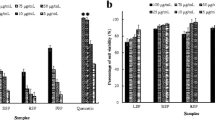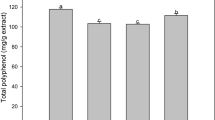Abstract
Curcumin is a natural polyphenol isolated from the rhizome of Curcuma longa with recognised therapeutic potential, namely as an anti-inflammatory, antioxidant, anticancer, and antidiabetic agent. Despite its potential biological properties, the low bioavailability of curcumin hinders its systemic effects. Recently, it was reported that the combination of curcumin with piperine increases their biological potential (e.g. antioxidant activity), by enhancing curcumin’s bioavailability. However, it is not known whether the two compounds have a direct synergic effect. In this study, we evaluated and compared the scavenging activity of physiological relevant reactive species by commercial curcumin extract, commercial piperine extract and their combination, using in vitro non-cellular and cellular systems. The obtained results revealed that the commercial curcumin extract scavenges hypochlorous acid and nitric oxide, while no scavenging effect was found against superoxide anion radical and hydrogen peroxide. The commercial curcumin extract also proved to be an effective inhibitor of neutrophils’ oxidative burst. Commercial piperine extract per se did not display any activity. Nevertheless, the obtained results for the combination of commercial curcumin extract with commercial piperine extract (1%) suggest that the commercial piperine extract potentiates the effects exerted by the commercial curcumin extract.
Graphic abstract





Similar content being viewed by others
References
Ak T, Gülçin İ (2008) Antioxidant and radical scavenging properties of curcumin. Chem Biol Interact 174(1):27–37. https://doi.org/10.1016/j.cbi.2008.05.003
Anand P, Kunnumakkara AB, Newman RA, Aggarwal BB (2007) Bioavailability of curcumin: problems and promises. Mol Pharm 4(6):807–818. https://doi.org/10.1021/mp700113r
Bano G, Raina RK, Zutshi U, Bedi KL, Johri RK, Sharma SC (1991) Effect of piperine on bioavailability and pharmacokinetics of propranolol and theophylline in healthy volunteers. Eur J Clin Pharmacol 41(6):615–617. https://doi.org/10.1007/BF00314996
Freitas M, Lima JLFC, Fernandes E (2009) Optical probes for detection and quantification of neutrophils’ oxidative burst. A Rev Anal Chim Acta 649(1):8–23. https://doi.org/10.1016/j.aca.2009.06.063
Gomes A, Fernandes E, Lima JLFC (2005) Fluorescence probes used for detection of reactive oxygen species. J Biochem Biophys Methods 65(2–3):45–80. https://doi.org/10.1016/j.jbbm.2005.10.003
Gomes A, Fernandes E, Silva AMS, Santos CMM, Pinto DCGA, Cavaleiro JAS et al (2007) 2-Styrylchromones: novel strong scavengers of reactive oxygen and nitrogen species. Bioorg Med Chem 15(18):6027–6036. https://doi.org/10.1016/j.bmc.2007.06.046
Hewlings SJ, Kalman DS (2017) Curcumin: a review of its effects on human health. Foods 6(10):92. https://doi.org/10.3390/foods6100092
Kesarwani K, Gupta R (2013) Bioavailability enhancers of herbal origin: an overview. Asian Pac J Trop Biomed 3(4):253–266. https://doi.org/10.1016/S2221-1691(13)60060-X
Kim M, Choi G, Lee H (2003) Fungicidal property of Curcuma longa L rhizome-derived curcumin against phytopathogenic fungi in a greenhouse. J Agric Food Chem 51(6):1578–1581. https://doi.org/10.1021/jf0210369
Kotha RR, Luthria DL (2019) Biological, pharmaceutical, nutraceutical, and analytical aspects. Molec 24(16):2930. https://doi.org/10.3390/molecules24162930
Nagata N, Momose K, Ishida Y (1999) Inhibitory effects of catecholamines and anti-oxidants on the fluorescence reaction of 4,5-diaminofluorescein, daf-2, a novel indicator of nitric oxide. J Biochem 125(4):658–661. https://doi.org/10.1093/oxfordjournals.jbchem.a022333
Noorafshan A, Ashkani-Esfahani S (2013) A review of therapeutic effects of curcumin. Curr Pharm Des 19(11):2032–2046. https://doi.org/10.2174/1381612811319110006
Nosáľ R, Drábiková K, Jancinová V, Mačičková T, Pečivová J, Perečko T et al (2015) On the pharmacology of oxidative burst of human neutrophils. Physiol Res 64:S445–S452. https://doi.org/10.33549/physiolres.933204
Nosáľ R, Drábiková K, Jančinová V, Mačičková T, Pečivová J, Perečko T et al (2017) Pharmacological intervention with oxidative burst in human neutrophils. Interdiscip Toxicol 10(2):56–60. https://doi.org/10.1515/intox-2017-0009
Oliveira S, Monteiro-Alfredo T, Silva S, Matafome P (2020) Curcumin derivatives for type 2 diabetes management and prevention of complications. Arch Pharm Res 43(6):567–581. https://doi.org/10.1007/s12272-020-01240-3
Panahi Y, Khalili N, Sahebi E, Namazi S, Simental-Mendía LE, Majeed M et al (2018) Effects of curcuminoids plus piperine on glycemic, hepatic and inflammatory biomarkers in patients with type 2 diabetes mellitus: a randomized double-blind placebo-controlled trial. Drug Res (stuttg) 68(7):403–409. https://doi.org/10.1055/s-0044-101752
Pattanaik S, Hota D, Prabhakar S, Kharbanda P, Pandhi P (2009) Pharmacokinetic interaction of single dose of piperine with steady-state carbamazepine in epilepsy patients. Phytother Res 23(9):1281–1286. https://doi.org/10.1002/ptr.2676
Pisoschi AM, Pop A (2015) The role of antioxidants in the chemistry of oxidative stress: a review. Eur J Med Chem 97:55–74. https://doi.org/10.1016/j.ejmech.2015.04.040
Qu H, Lv M, Xu H (2015) Piperine: bioactivities and structural modifications. Mini Rev Med Chem 15(2):145–156. https://doi.org/10.2174/1389557515666150101100509
Reddy ACP, Lokesh BR (1994) Studies on the inhibitory effects of curcumin and eugenol on the formation of reactive oxygen species and the oxidation of ferrous iron. Mol Cell Biochem 137(1):1–8. https://doi.org/10.1007/bf00926033
Ribeiro D, Freitas M, Tomé SM, Silva AMS, Porto G, Fernandes E (2013) Modulation of human neutrophils’ oxidative burst by flavonoids. Eur J Med Chem 67:280–292. https://doi.org/10.1016/j.ejmech.2013.06.019
Sahu PK, Sahu PK, Sahu PL, Agarwal DD (2016) Structure activity relationship, cytotoxicity and evaluation of antioxidant activity of curcumin derivatives. Bioorg Med Chem Lett 26(4):1342–1347. https://doi.org/10.1016/j.bmcl.2015.12.013
Sharma S, Kumar M, Sharma S, Nargotra A, Koul S, Khan IA (2010) Piperine as an inhibitor of Rv1258c, a putative multidrug efflux pump of Mycobacterium tuberculosis. J Antimicrob Chemother 65(8):1694–1701. https://doi.org/10.1093/jac/dkq186
Shoba G, Joy D, Joseph T, Majeed M, Rajendran R, Srinivas PSSR (1998) Influence of piperine on the pharmacokinetics of curcumin in animals and human volunteers. Planta Med 64(04):353–356. https://doi.org/10.1055/s-2006-957450
Smilkov K, Ackova DG, Cvetkovski A, Ruskovska T, Vidovic B, Atalay M (2019) Piperine: old spice and new nutraceutical? Curr Pharm Des 25(15):1729–1739. https://doi.org/10.2174/1381612825666190701150803
Sreejayan, Rao MNA (1997) Nitric oxide scavenging by curcuminoids. J Pharm Pharmacol 49(1):105–7. https://doi.org/10.1111/j.2042-7158.1997.tb06761.x
Velpandian T, Jasuja R, Bhardwaj RK, Jaiswal J, Gupta SK (2001) Piperine in food: interference in the pharmacokinetics of phenytoin. Eur J Drug Metab Pharmacokinet 26(4):241–247. https://doi.org/10.1007/BF03226378
Yadala P, Viswanathswamy AHM (2016) In vitro antioxidant and cytotoxic activity of rutin and piperine and their synergistic effect. Int J Pharm Pharm Sci 8(5):78–82
Youssef KM, El-Sherbeny MA, El-Shafie FS, Farag HA, Al-Deeb OA, Awadalla SAA (2004) Synthesis of curcumin analogues as potential antioxidant, cancer chemopreventive agents. Arch Pharm 337(1):42–54. https://doi.org/10.1002/ardp.200300763
Acknowledgements
We gratefully acknowledge Centro Hospitalar do Porto-Hospital de Santo António blood bank- Serviço de Hematologia Clínica, for the collaboration in the recruitment of blood donors to participate in the study. This work received financial support from PT national funds (FCT/MCTES, Fundação para a Ciência e Tecnologia and Ministério da Ciência, Tecnologia e Ensino Superior) through the project UIDB/50006/2020 and from the European Union (FEDER funds through the Operational Competitiveness Program (COMPETE2020) POCI-01-0145-FEDER-029253—Project PTDC/MED-QUI/29253/2017). Marisa Freitas acknowledges the financial support from the European Union (FEDER funds through COMPETE POCI-01-0145-FEDER-029248). Jadriane A. Xavier, Fabiana A. Moura, Marília O. F. Goulart acknowledge the Research Support Foundation of Alagoas State (FAPEAL) and also the joint financial support from the Brazilian Health Ministry and FAPEAL, through the grant PPSUS number 60030-000876/2016.
Author information
Authors and Affiliations
Corresponding author
Ethics declarations
Conflict of interest
The authors declare that they have no conflicts of interest.
Ethical approval
All procedures performed in studies involving human participants were in accordance with the ethical standards of the institutional and/or national research committee and with the 1964 Helsinki Declaration and its later amendments or comparable ethical standards.
Informed consent
Informed consent was obtained from all individual participants included in the study.
Additional information
Publisher's Note
Springer Nature remains neutral with regard to jurisdictional claims in published maps and institutional affiliations.
Rights and permissions
About this article
Cite this article
Lucas, M., Freitas, M., Xavier, J.A. et al. The scavenging effect of curcumin, piperine and their combination against physiological relevant reactive pro-oxidant species using in vitro non-cellular and cellular models. Chem. Pap. 75, 5269–5277 (2021). https://doi.org/10.1007/s11696-021-01710-y
Received:
Accepted:
Published:
Issue Date:
DOI: https://doi.org/10.1007/s11696-021-01710-y




